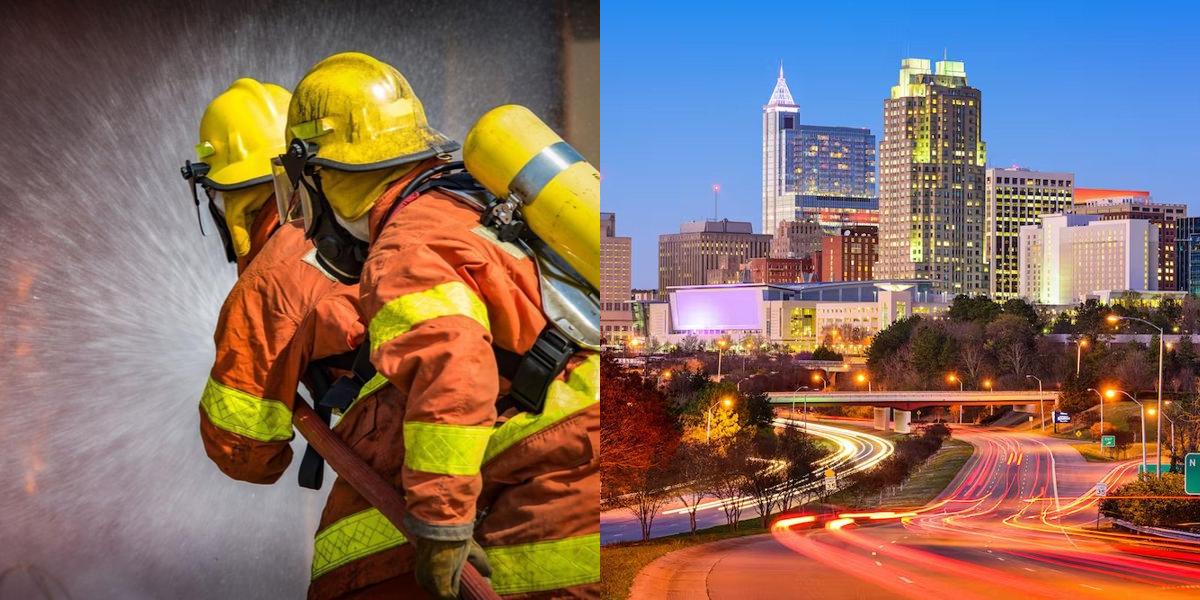How to Become a Firefighter in North Carolina

What is a Firefighter?
A firefighter is a brave and dedicated professional who plays a crucial role in protecting lives and property during emergencies, particularly fires. Their primary responsibility is to respond to and extinguish fires, but they also provide medical assistance, perform rescues, and educate the public on fire prevention and safety.
Step 2: Research fire departments
Research fire departments in your area to find out about their hiring process and requirements. Visit their websites and look for information on how to apply, what qualifications they are looking for, and any upcoming recruitment events.
It is also a good idea to reach out to current firefighters or fire department employees to learn more about the hiring process and what it is like to work for a particular department. They may be able to provide you with valuable insights and advice.
Step 3: Submit your application
Once you have gathered all the necessary documents and researched fire departments, you can start submitting your applications. Follow the instructions provided by each fire department and make sure to submit all required documents and forms.
In your application, highlight your relevant experience, certifications, and training. Tailor your resume and cover letter to each specific fire department, emphasizing how your skills and qualifications make you a strong candidate for the position.
Step 4: Prepare for the hiring exams
Once your application has been submitted and reviewed, you may be invited to participate in the hiring process, which typically includes written exams, physical agility tests, interviews, and background and medical checks.
Prepare for the written exams by studying firefighting principles and procedures. There are many resources available, such as textbooks, online courses, and practice exams, that can help you prepare for the written portion of the hiring process.
For the physical agility tests, focus on improving your strength, endurance, and cardiovascular fitness. Practice the specific tasks that are typically included in the physical agility test, such as ladder climbs, hose pulls, and stair climbs.
Step 5: Ace the interviews
The interview is a crucial part of the hiring process. It is your opportunity to showcase your communication skills, problem-solving abilities, and your fit with the fire department's culture.
Prepare for the interview by researching common interview questions and practicing your responses. Think about your experiences and how they relate to the skills and qualifications required for the position. Be prepared to provide specific examples that demonstrate your abilities.
During the interview, be confident, professional, and enthusiastic. Show your passion for firefighting and your commitment to public safety. Remember to ask questions about the fire department and the role of a firefighter to demonstrate your interest and engagement.
Career Paths and Opportunities after Becoming a Firefighter
After becoming a firefighter, there are various career paths and opportunities that you can explore. While firefighting itself is a rewarding and fulfilling career, there are also opportunities for advancement and specialization within the field. Let's discuss some of the career paths and opportunities available to firefighters.
1. Promotions within the fire department
Once you have gained experience as a firefighter, you may have the opportunity to advance within the fire department. Promotions are typically based on a combination of experience, performance, and education.
Some common ranks within a fire department include:
- Fire engineer: Responsible for driving and operating fire trucks and other emergency vehicles.
- Fire lieutenant: Oversees a team of firefighters and manages fire suppression activities.
- Fire captain: In charge of a fire station and responsible for the safety and performance of the firefighters under their command.
- Battalion chief: Manages multiple fire stations and oversees firefighting operations in a specific geographic area.
- Fire chief: The highest-ranking officer in a fire department, responsible for the overall management and administration of the department.
2. Specialization
Firefighters can also choose to specialize in specific areas of firefighting. Some common specializations include:
- Hazardous materials (Hazmat) response: Involves responding to incidents involving hazardous materials, such as chemical spills or gas leaks.
- Technical rescue: Involves rescuing individuals from confined spaces, collapsed buildings, or other challenging situations.
- Wildland firefighting: Involves responding to and extinguishing fires in rural or wilderness areas.
- Arson investigation: Involves determining the cause and origin of fires and working closely with law enforcement agencies.
Specializing in a specific area can provide you with additional training and certifications, as well as open up new career opportunities within the fire service.
3. Training and education
Continuing education and training are essential for firefighters to stay updated on the latest techniques, equipment, and procedures. Fire departments often offer ongoing training programs to help firefighters improve their skills and knowledge.
In addition to department-provided training, firefighters can also pursue further education in fire science or related fields. A degree in fire science or a related field can provide you with a deeper understanding of firefighting principles and open up opportunities for leadership roles within the fire service.
4. Emergency management
Firefighters are often on the front lines during emergencies and disasters. This experience can provide valuable skills and knowledge in emergency management. Many firefighters go on to work in emergency management roles, such as emergency management coordinators or emergency management directors.
In these roles, firefighters can use their experience and expertise to develop and implement emergency response plans, coordinate resources during disasters, and ensure the safety of the community in times of crisis.
How Much does a Firefighter Make?
The salary of a firefighter can vary based on factors such as location, experience, and the size of the fire department. According to the Bureau of Labor Statistics, the median annual wage for firefighters was $50,850 in May 2020. The lowest 10 percent earned less than $25,850, while the highest 10 percent earned more than $94,720.
For entry-level firefighters, the starting salary can be lower than the median wage. However, as they gain experience and move up the ranks, their salary can increase significantly. It's important to note that these figures are just averages, and the actual salary can vary depending on various factors.
Final Thoughts
Becoming a firefighter is a challenging and rewarding career choice. It requires dedication, physical fitness, and a commitment to public safety. By obtaining your firefighter certification, you will have the necessary skills and knowledge to protect and serve your community.
Remember to research the requirements in your state, complete the necessary training, and pass the certification exams. Once you have obtained your firefighter certification, you can start applying for firefighter positions and pursuing your career as a firefighter.
With experience and additional training, there are various career paths and opportunities available to firefighters. Whether you choose to advance within the fire department, specialize in a specific area, or pursue further education, there are many ways to grow and develop as a firefighter.
If you are passionate about helping others, have a strong desire to serve your community, and thrive in high-pressure situations, a career as a firefighter may be the perfect fit for you. Start your journey to becoming a firefighter today and make a difference in the lives of others.
Exploring a variety of professional opportunities? Dreambound has many extensive guides to help you make informed decisions. Check out these guides:

Fel is a student support representative who guides enrollees to the right program and answers their queries. She's committed to helping students and takes pride in her work. In her free time, she enjoys sightseeing and hanging out with loved ones.




